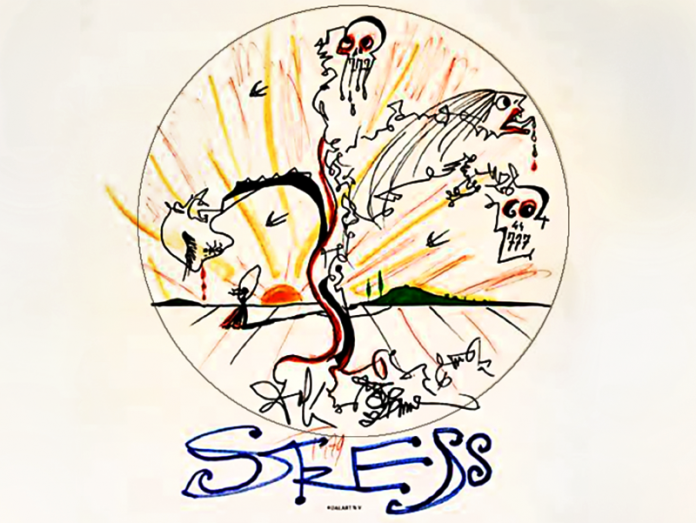
By Dr. Simon L. Dolan and Dr. Salvador Garcia Sanchez[1]
A few years back, we published several books dealing with Stress, Self -Esteem, Health and Work, which was intended to understand the phenomenon is work settings (Dolan 2007; Dolan & Arsenault 1980 and 2010; Dolan, García & Diez-Piñol, 2015). The books have been written in different languages for people who did not understand the scope and the reasons for them to suffer from stress, depression, burnout and other psychological ailments. Mind you, similar to the current situation with the COVID-19 pandemic who is infecting millions of people throughout the globe, there were no (or very few) reliable and valid measures to detect chronic stress and trace its impact of the psychological and physical health of the workers. Back in the 1980s, 1990s, and 2000s, the focus of scholarly work was really to develop models and reliable measures that will enable the true understanding and predictions of what was described as the “hidden Pandemic”; it has no color neither odor, but caused suffering, ill health and even deaths. The WHO is repeatedly releasing reports showing that every 40 seconds there is someone in the world that commits suicide due to depression and anxiety resulting from stress (WHO report, Sept. 9, 2019). Obviously, the signs and symptoms of acute stress are by far easier to detect and perhaps intervene, but the signs and symptoms of chronic stress are more complicated and resemble the COVID-19 individuals who are positive but show no symptoms. Once the symptoms are manifested, the disease is at an advanced state and intervention becomes more complicated. The same is true to chronic stress; by the time clear symptoms show, (can happen years later not just 14-15 days as is the case of the COVID-19), in the case of stress interventions might be too late or perhaps too difficult to remedy. Thus, this led to the developments of thousands of researchers publishing articles targeting, modeling and measuring chronic stress in view of intervening and preventing depression, anxiety or even suicides, not to mention real physical diseases. It also led to the emergence of new “buzzwords” and syndromes in this field of stress, like burnout, personality prone to stress (Type A people), and alike. Similarly, a host of concepts borrowed from positive psychology were introduced to deal with acute and/or chronic stress such as resilience, hardiness, and recently mindfulness.
We, the authors of this paper, also contributed to the filed by adding innovative and insightful components that might explain whether or not individual have the psychological resources to mitigate or by contrast to exacerbate the effects of stress; namely we proposed over the years that in 99% of work related stress is generated because our way of understanding what is happening depends on our perception. Cognition plays a key role in the etiology of occupational stress; to a large extend it depends on the “eye of the beholder”. Our cognitive interpretation of the situation depends on two inter-related yet independent variables: 1) our assessment of our “Self Esteem” (which in many cases is implicit hence we are not always aware of it) , and 2) our values, or our form of living that is either congruent or incongruent with our values (Bao et al 2013; Dolan 2016). We argue that the communities of professionals who wish to help stress victims need a clear model and a reliable measure(s) of assessment characterized by relative simplicity in order to quickly understand the situation and consequently intervene rapidly. By analogy, this is very similar (albeit other hidden enemy), as is the current situation of COVID-19. In our published books we present the full complexity of the stress model, hence stress is a multifactorial and multidisciplinary field of study. Nonetheless, for practical purposes, and based on over 15 years’ experience in detecting core values, that use simple heuristic models and tools, we noticed significant instrumentality in helping people. While our assessment is research- based, and while we acknowledge the fact that we do not capture the full complexity of the stress phenomenon, nevertheless it provided the best solution for those suffer from stress, depression and anxiety. So, in the remainder of this paper, we attempt to apply similar principles to the situation that we all experience today be it as citizen confined at home, or health workers helping to fight the disease and savings life. We argue that the beauty of our proposal is its simplicity in the tools that we have elaborated and these can be used by anyone, ranging from people who may use it as self-help to professionals that can do a quick diagnosis and perhaps complement it with more comprehensive assessment.
Brief background and conclusions about the importance of “self-Esteem” in the etiology of stress
There is ample research that deals with the importance of a person’s image of self-value and self confidence in all aspects of human activity including work and non-work contexts. Studies all over the world have associated self-esteem with human health and psychological well-being. This effect may be interpreted through the scope of resources increase and active coping against life’s problems. Moreover, there seems to be a strong antistressor impact on self-esteem regardless of the circumstances. High self-esteem is considered a fundamental aspect of personal well-being, happiness, and adjustment. Individuals with higher self-esteem are more satisfied with their lives, have fewer interpersonal problems, achieve at a higher and more consistent level, and are less susceptible to psychological problems as well as to a variety of physical illness than those with lower self-esteem.
Self-esteem refers to the positive or negative way people feel about themselves. Self-esteem seems to be associated with stressors that have to do with emotion. Low self-esteem is sometimes called low self-worth. It is perhaps too early to speculate, but we argue that the people that suffer the most during the COVID-19 crisis, are those that have relatively low self-esteem. We predict that research in the future will reinforce this hypothesis. For the moment, we only have anecdotes and journalistic reports that indirectly support this claim. Here are two typical examples from India and the other one from Australia:
-
- A string of suicides rocked India in different states in the past few days: a 61 years-old man ended his life by jumping off his second floor flat after penning a suicide note stating he was tired of the pandemic situation ; a 31 years old man ended his life fearing he has contracted the Covid-19 infection; A 75 years old hanged himself and left a note that it was a coronavirus fear; a 30 years old asymptomatic man who was tested positive , committed suicide by slitting his throat while he was in isolation ward of a state run medical college
(Source: the Times of India, April 12,2020)  A “beautiful” teen who feared being isolated with coronavirus tragically died after attempting to take her own life. The young waitress, who had high-functioning autism, was said to have been unable to cope “with her world closing in, plans being cancelled and being stuck inside” Emily was very concerned about coronavirus itself but more concerned about the mental health impact of isolation and the fear of the unknown,” Emily’s sister Annabel Owen, 21, said in a tribute, posted online.
A “beautiful” teen who feared being isolated with coronavirus tragically died after attempting to take her own life. The young waitress, who had high-functioning autism, was said to have been unable to cope “with her world closing in, plans being cancelled and being stuck inside” Emily was very concerned about coronavirus itself but more concerned about the mental health impact of isolation and the fear of the unknown,” Emily’s sister Annabel Owen, 21, said in a tribute, posted online.
(Source: news.com.au March 26, 2020) A 34-year old Italian nurse who was working on the frontline of the coronavirus crisis at a hospital in Lombardy, the worst-affected region of Italy, committed suicide after testing positive for coronavirus. Daniela Trezzi, who worked in the intensive care unit of the San Gerardo Hospital in the city of Monza, killed herself out of fear that she was spreading the virus, the National Federation of Nurses of Italy said in a statement late Tuesday, expressing “pain and dismay.”
A 34-year old Italian nurse who was working on the frontline of the coronavirus crisis at a hospital in Lombardy, the worst-affected region of Italy, committed suicide after testing positive for coronavirus. Daniela Trezzi, who worked in the intensive care unit of the San Gerardo Hospital in the city of Monza, killed herself out of fear that she was spreading the virus, the National Federation of Nurses of Italy said in a statement late Tuesday, expressing “pain and dismay.”
(Source: Daily Sabah March 25, 2020) New York ER doctor who treated coronavirus patients dies by suicide. She was at top emergency room doctor in New York who was working on the frontline trying to save coronavirus victims at the height of the pandemic and also suffered the disease herself. has died. Dr. Breen had previously contracted the coronavirus herself. She later went back to work after recuperating for about a week and a half.
New York ER doctor who treated coronavirus patients dies by suicide. She was at top emergency room doctor in New York who was working on the frontline trying to save coronavirus victims at the height of the pandemic and also suffered the disease herself. has died. Dr. Breen had previously contracted the coronavirus herself. She later went back to work after recuperating for about a week and a half.
(Source: The Guardian, April 28,2020)
- A string of suicides rocked India in different states in the past few days: a 61 years-old man ended his life by jumping off his second floor flat after penning a suicide note stating he was tired of the pandemic situation ; a 31 years old man ended his life fearing he has contracted the Covid-19 infection; A 75 years old hanged himself and left a note that it was a coronavirus fear; a 30 years old asymptomatic man who was tested positive , committed suicide by slitting his throat while he was in isolation ward of a state run medical college
Being cut off from friends and family, facing the monotony of the interior of our premises, mingled only with the prospect of losing our jobs in a looming economic crisis, and the fear of losing our own life and the life of those we love during the pandemic, can impact millions of us. Suicides hotlines in most European and North American continent sees a sharp rise. Again, we argue that substantially less people who have high self-esteem and who lives in congruence with their values, will be the one clogging on the hotlines or the one who commit suicide.
So, what more do we need to know about self-esteem? feelings of self-worth tend to drop under failure; people who fail are more concerned about self-protection in stressful situations, and they are more likely to have depressive attributions in response to negative events. They also tend to overgeneralize the negative consequences of a stressful situation and find it difficult to repair their negative moods. The effects of these maladaptive responses to stressful situations can be aggravated when stressors are perceived as threatening and uncontrollable, like the current pandemic situation. These can further impede an individual’s ability to cope successfully and, those perceptions only verify the initial negative biases. In line with our proposed cognitive model of stress, self-esteem is associated with adaptation to stressful situations by changing the impact of the appraisal during the adaptational process. Research has reported systematically that people with low self-esteem exaggerate the negative impacts on outcomes and those with high self-esteem, used more neutral appraisal to mitigate the negative outcomes. In other words, high self-esteem attenuated the detrimental effect of negative stressor appraisals on daily negative effect.
Brief background and conclusions about the importance of living in congruence or incongruence with your core values in the etiology of stress
Why Value incongruence? Our 35 years of accumulated research on values (García & Dolan 1997; Dolan, Garcia and Richley 2006, and Dolan 2011 and 2020, Garcia 2018) shows us very clearly that if we do not understand our core values, the ambiguity leads to stress. Moreover, if we do not align our daily conduct to our core values, it leads to a state of incongruency and consequently leads to a host of psychological and physical ailments (Bao et al 2013, Dolan 2016).
While research on value congruence and stress is scant, the limited studies amongst clinicians working in intensive care units often exposed to numerous stressors (i.e., the risk of being infected by the Corona virus), shows that it affects their mental state and health. Among them, those who understood clearly their values, report less symptoms of depression and had much more vigor to assume their responsibilities (Lamiani, Dordoni and Argentero, 2017). In our own case, we have developed over the years a concept, a methodology, and tools to measure values incongruence using a Triaxial Model. Using the latter, people can be helped in discovering what are their core values and how these are distributed along the axes. Our research shows that if you don’t have a minimum of 1 value in each of the axis, the situation is not sustainable as incongruency frequently occurs. Moreover, if our daily conduct is not aligned with our core values, it leads to stress, depression, anxiety and other ailments (Dolan, 2020) . More information on the Triaxial model and its relevance to the COVID/19 crisis, can be seen in a recent papers we have published in this Journal (Garti and Dolan , 2019; Dolan et al, 2020).
So, an interesting manner to pose a diagnosis is to assess the combined classification of Self-Esteem and values. This can help map the probability of developing depression, anxiety and even suicides based on the quadrant that the person is being placed. Figure 1 proposes our classification:
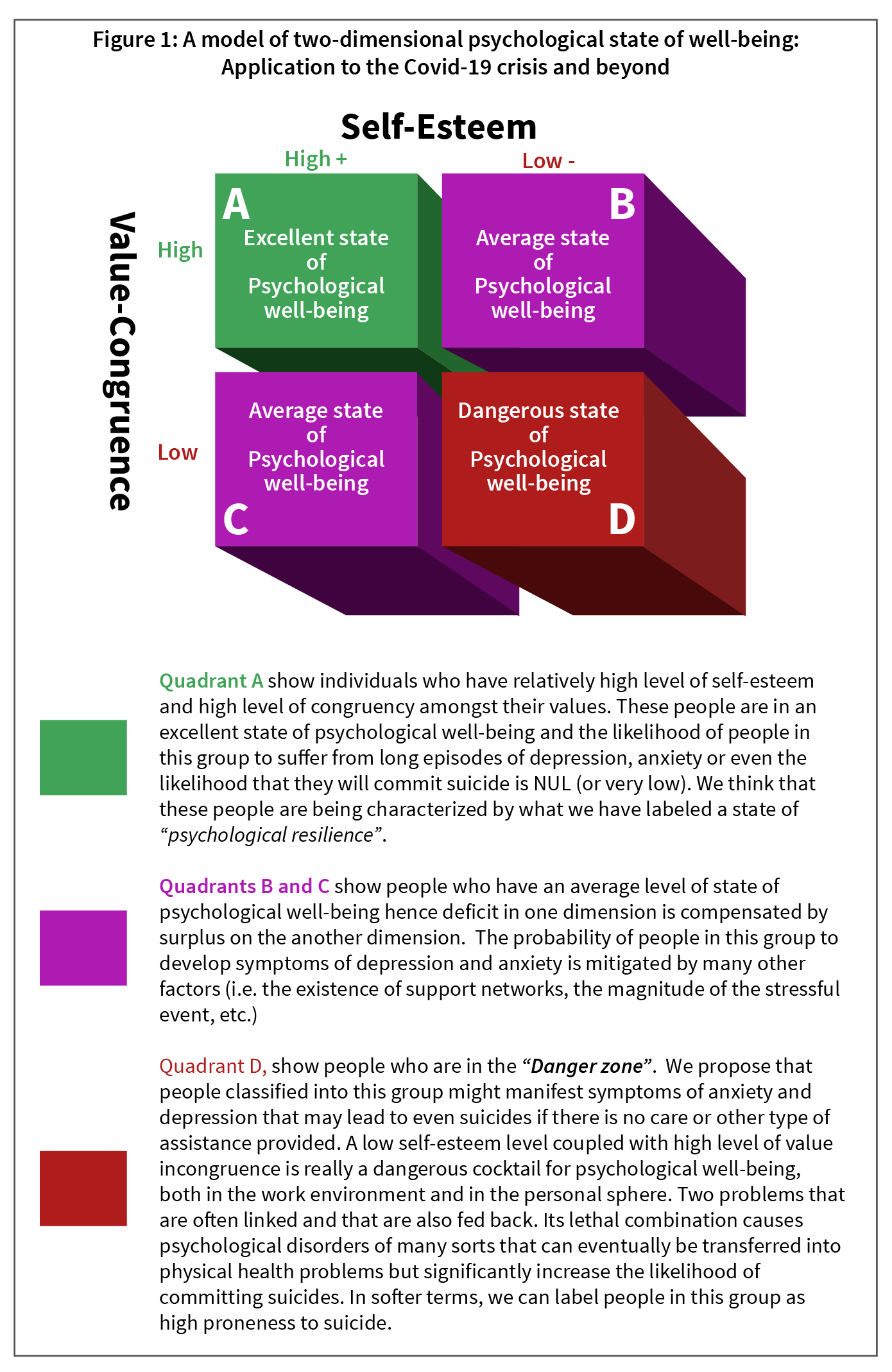
The normal way to assess self-esteem is to combine a valid paper and pencil tool with other methods which may include projective tests and observations. Actually. there are tens of various validated assessments available, many which were developed for applications with children or adolescents, but others were developed for psychiatric wards and for adults in work settings. Nonetheless, most of them are not applicable to the context of the COVID-19 that we are living today during the confinement. In this period, we need to use a rapid virtual method(s) in order to detect people who are in the danger zone with the view of reducing the probability of state depression or anxiety and mitigating the likelihood of suicide. Thus, we are aware of the tradeoff between scientific validity and practicality. Additionally, after long weeks of confinement, people that are being approached, albeit the paradox that it is for their own good, have no patience, and indeed they even become irritated with lengthy assessments. In this vein, we are proposing a “quick and dirty” assessment that can be used by almost any professional, and if risk has been detected, a health professional can be signaled for providing help. We have developed the tool based on Rosenberg scale that is often used in the field of social work. While the original tool is by itself relatively short, it uses a 4 points rating scale which takes time, so we have reduced it into a simple “Yes” or “No” reply. Table 1 provides the list of questions for this assessment:
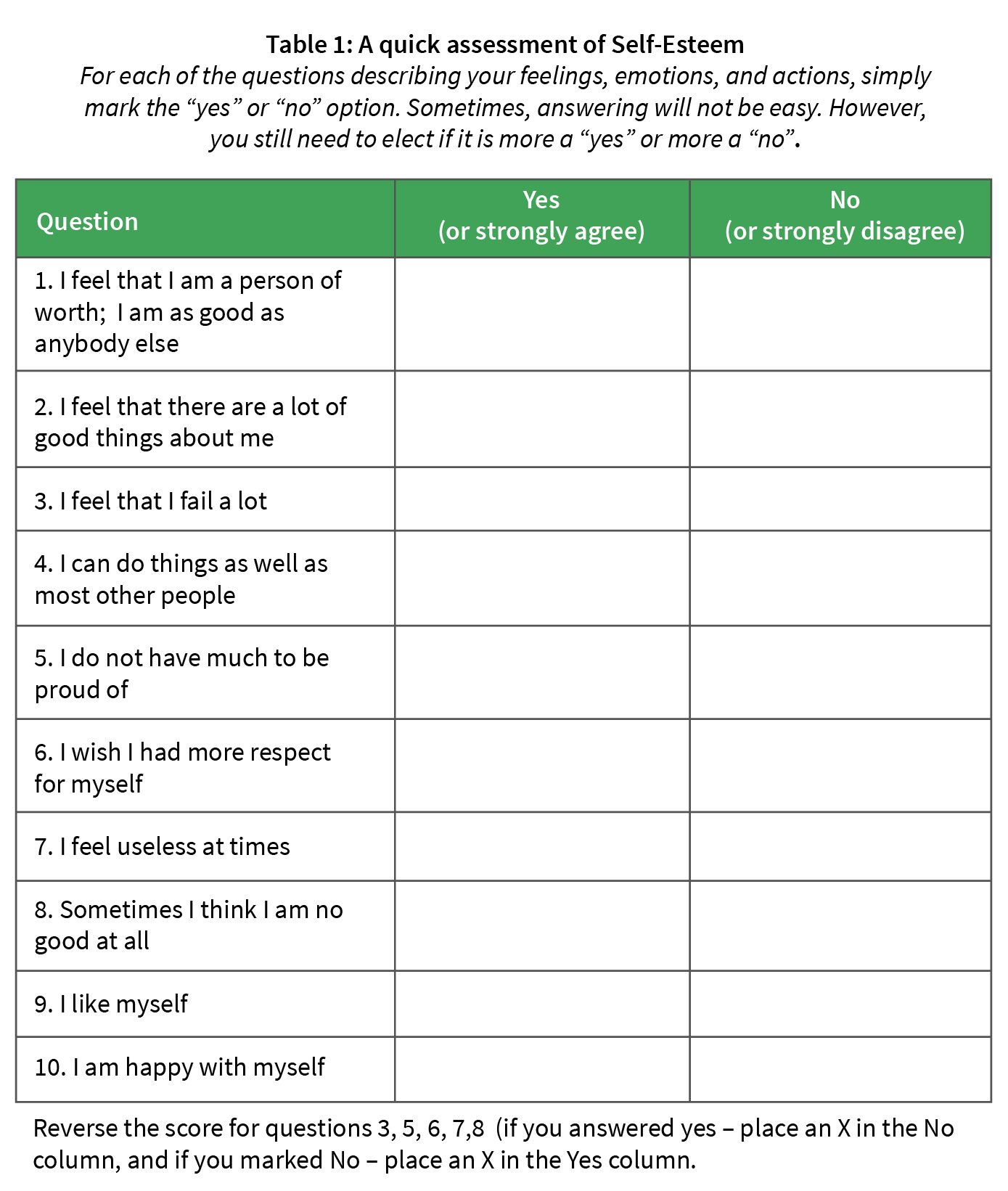 The scale ranges from 1 to 10. If you have accumulated a total of 6 and more no, it suggests low self-esteem. In order to calculate the quadrants proposed in Figure 1, we use a median split where 50% above and below can be placed on the figure. (Modified from Rosenberg 1965): http://www.socialworkerstoolbox.com/rosenberg-self-esteem-scale/. used with permission.
The scale ranges from 1 to 10. If you have accumulated a total of 6 and more no, it suggests low self-esteem. In order to calculate the quadrants proposed in Figure 1, we use a median split where 50% above and below can be placed on the figure. (Modified from Rosenberg 1965): http://www.socialworkerstoolbox.com/rosenberg-self-esteem-scale/. used with permission.
Similarly, the assessment of value congruence (and/or incongruence) is also lengthy. In the field of values, there are tens of different manners to define values, to measure values and to connect them with real life conduct. In the past 35 years or so we have studied values, and the evolution of the research helped us to frame a concept ( Dolan et al, 2006, Garcia and Dolan 1997), a methodology (Dolan, 2011) and tools (Dolan, 2020). These were the fundamental principles for the development of the coaching by values community which until today teaches and certifies people in understanding and detecting what is important to them and helping them align their conducts with their values . In order to do that, we are applying methods that are fun and easy to use, based on gamification techniques and principles (Garti & Dolan, 2014). We also use a card game/tool called: the “Value of Values TM” (see: www.learning-about-values.com or www.coachingxvalores.com). While we are trying to adapt these tools to the virtual reality in the COVID-19 context, we also developed a simple assessment based on 10 questions, that can be used in a cruder manner (see table 2). Imagine, that the assessment is being conducted by a virtual coach, a therapist, a psychologist, or other health professional in a form of an interview. It is the interviewer that keeps the assessment template at hand and marks the answer in the corresponding columns. Based on this interview, diagnosis can be rendered in a few minutes. We argue that the beauty of the assessment is in its simplicity.
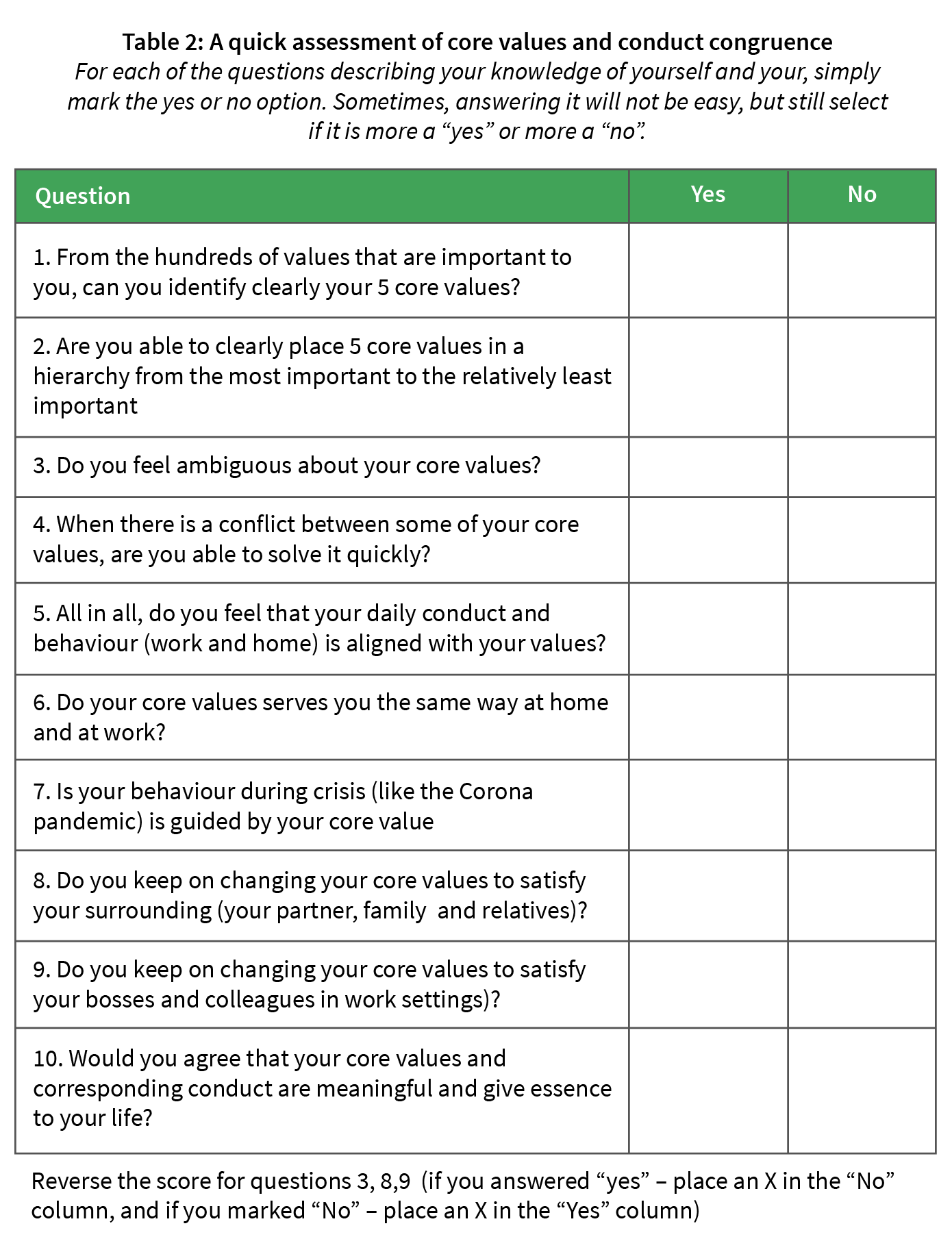 The scale ranges from 1 to 10. If you have accumulated a total of 6 and more “no”, it suggests a relatively high level of value-incongruence. In order to calculate the quadrants proposed in Figure 1, we use again a median split where 50% above and below can be placed on the figure. (Modified from concepts developed by Dolan, Garcia and Richley (2006) and Dolan (2011 and 2020).
The scale ranges from 1 to 10. If you have accumulated a total of 6 and more “no”, it suggests a relatively high level of value-incongruence. In order to calculate the quadrants proposed in Figure 1, we use again a median split where 50% above and below can be placed on the figure. (Modified from concepts developed by Dolan, Garcia and Richley (2006) and Dolan (2011 and 2020).
Conclusions:
In hospitals around the world, doctors, nurses and other healthcare workers are fighting an enemy that has already killed more than hundreds of thousands of people, including close to 60,000 in the United States alone. And as with any war, the fight against COVID-19 will result not just in direct casualties, but also take a terrible toll on the psychological state of many of those who survive.
It will be years before the mental health toll of the COVID-19 pandemic is fully understood, but some early data already paints a bleak picture. A study published March 23 in the Journal of the American Medical Association (JAMA) by Jianbo et al (2020) found that, among 1,257 healthcare workers working with COVID-19 patients in China, 50.4% reported symptoms of depression, 44.6% symptoms of anxiety, 34% insomnia, and 71.5% reported distress. Nurses and other frontline workers were among those with the most severe symptoms. Obviously, the COVID-19 represent a real and severe stress as they wonder about the adequacy of their protective gear, they were afraid of spreading the disease to their families and had to deliver service in an area that is still a puzzle and unknown not for the way it spreads but also the choice of effective remedies and treatment. So, we do have early data on the symptoms of ailments, but we do not have data on the one that are resilient and can mitigate the negative psychological well-being. We claim that the one who have the least severe symptoms are the one that have high value of dedication to the profession, to the gift of providing care and similar social-ethical values. Their values and their conduct are very coherent. We also argue that most likely, at the same time, these people benefit from a high level of self-esteem. At this point, it is only a hypothesis, but with time we will find out if these assertions are true.
And, as to the general population, a recent paper by Pfefferbaum and North (2020) published in the New England Journal of Medicine, conclude that Millions of people are being impacted by the psychological fallout from the COVID-19 pandemic and its economic aftermath, and large numbers may experience emotional distress and be at increased risk of developing psychiatric/psychological disorders such as depression and anxiety. They have previously studied survivors of disasters including the 9/11 terrorist attacks and Hurricane Katrina, and call to monitor the psychosocial needs of their patients as well as themselves and fellow health care workers during this time. A recent review of the effects on quarantined people and health care providers in earlier disease outbreaks found stress, depression, insomnia, fear, anger, and boredom, among other problems. Interestingly enough, the co-author of the study. Dr. North also points out that a great number of people do not develop psychiatric ailments as they seem to be resilient (see: https://www.news-medical.net/news/20200415/Depression-anxiety-may-be-side-effects-of-COVID-19-pandemic.aspx). We argue, of course, that the different proportions of resiliency lies with people who have relatively high level of self esteem and high level of value congruence.
Helping people that are in the danger zone of being depressed and anxious or have high probability to commit suicide is very important. What needs to be done by coaches, therapists, psychologists and other health professionals is to be able to diagnose on time, and assess rapidly the emotional state of a person via virtual tools or face to face with a focus on combined levels of self-esteem and value incongruency. In order to do so, we need to deploy “quick and dirty” measures. During the COVID-19 confinement, emphasis should be placed on boosting self-Esteem and ensuring that people (be they health care workers or those confined at home) are consciousness of their core values (what is really important to them and that the latter are aligned with their realistic goals and objectives), as well as ensuring that self-esteem remains high. How to do that, might be a matter of another long paper, but in order to end the paper with a positive and optimistic note, we offer a list of selected tips that can be deployed and served instrumentally to those in need. It is not a panacea, but it offers self-help to many that are confined at home, and of course to health professionals who can expand their menu of remedies in concrete suggestions. Remember, priorities should be given to diagnose and provide help to those classified in Quadrant D (figure 1), but others can benefit from these tips as well.
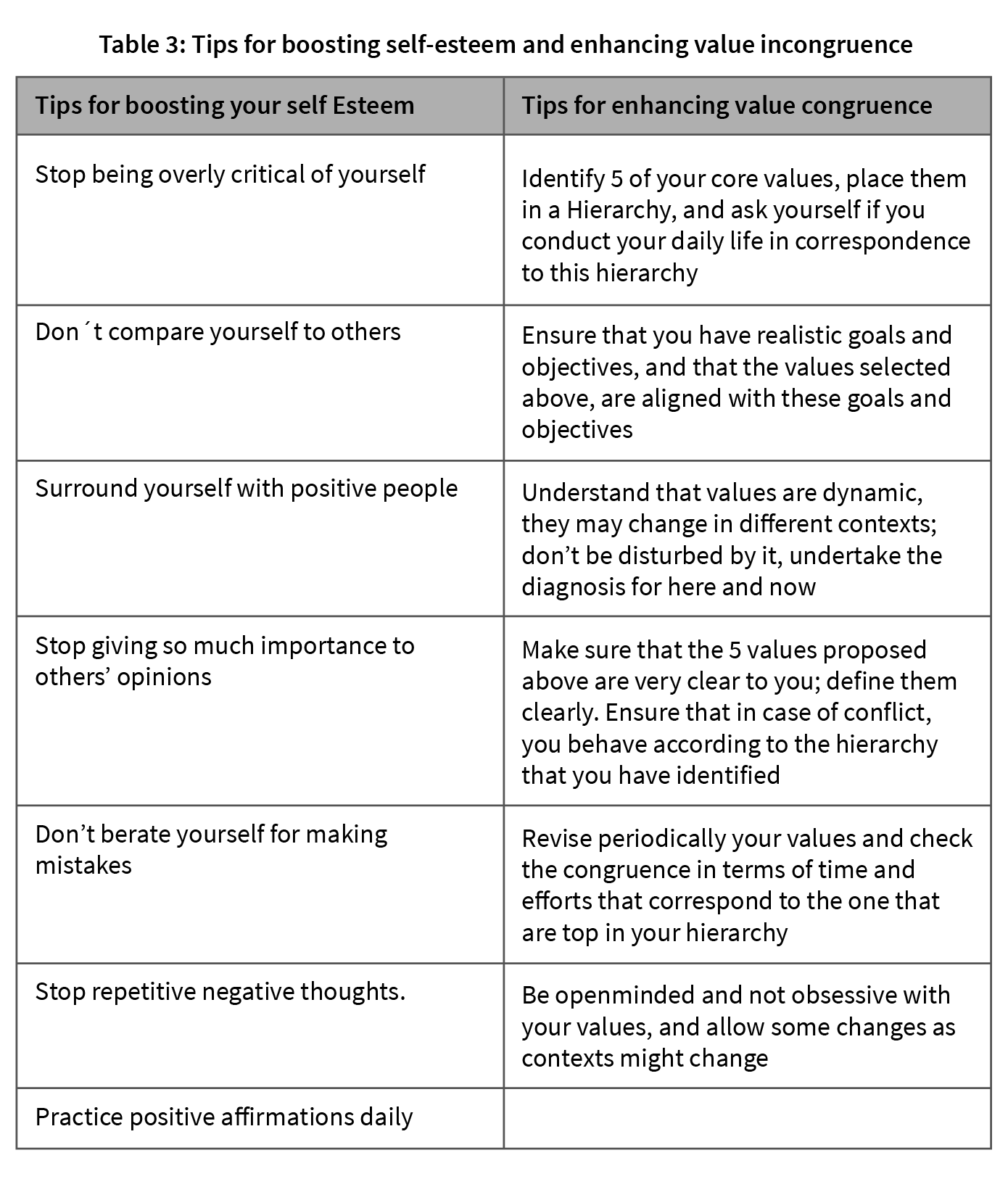
About the Authors
 Dr. Simon L- Dolan (Ph.D) is a prolific author with over 75 books and 250 articles published in professional and scientific journals. He is currently the president of the not for the profit Global Future of Work Foundation (www.globalfutureofwork.com), and former Future of Work Chair professor at ESADE Business School. He is also the founder of the concept, methodology and tools of the Coaching and Leading by Values” (www.coachingxvalores.com and www.leadershipbyvalues.com). More on his activities at: www.simondolan.com
Dr. Simon L- Dolan (Ph.D) is a prolific author with over 75 books and 250 articles published in professional and scientific journals. He is currently the president of the not for the profit Global Future of Work Foundation (www.globalfutureofwork.com), and former Future of Work Chair professor at ESADE Business School. He is also the founder of the concept, methodology and tools of the Coaching and Leading by Values” (www.coachingxvalores.com and www.leadershipbyvalues.com). More on his activities at: www.simondolan.com
 Dr. Salvador García (M.D.) is a Medical Doctor and a Social Humanist Psychologist. For years, he has been developing his vision of biopsychosocial health based on values. He is a professor of human resource development, entrepreneurship and social innovation at the University of Barcelona (UB). He has extensive experience in business humanization consulting. He studies and promotes the Triaxial Values Intelligence, which includes the components of ethical, pragmatic, and emotional-generative axes. He is also a strong believer in the role of love, trust, and coherence that underpins his triaxial model of values.
Dr. Salvador García (M.D.) is a Medical Doctor and a Social Humanist Psychologist. For years, he has been developing his vision of biopsychosocial health based on values. He is a professor of human resource development, entrepreneurship and social innovation at the University of Barcelona (UB). He has extensive experience in business humanization consulting. He studies and promotes the Triaxial Values Intelligence, which includes the components of ethical, pragmatic, and emotional-generative axes. He is also a strong believer in the role of love, trust, and coherence that underpins his triaxial model of values.
[1] The authors wish to thank Mrs. Keren Dolan for a speedy quality copyediting as well as insightful comments made on an earlier version of this paper.
References
1. Bao Y., Vedina R., Moodie S., Dolan S.L., (2013) The relationship between value incongruence and individual and organizational well‐being outcomes: an exploratory study among Catalan nurses, Journal of Advanced Nursing, Vol 69 (3): 631-641
2. Dolan, S.L., (2020) The secrets of coaching and Leading by Values. London. Routledge.
3. Dolan S.L., (2016) “Reflections on Leadership, Coaching and Values: A framework for understanding the consequences of value congruence and incongruence in organizations and a call to enhance value alignment”, The Study of Organizations and Human Resource Management Quarterly, Vol 1(2); 56-74
4. Dolan S.L., (2011) Coaching by Values; How to succeed in the life of Business and the Business of life”. iUniverse.
5. Dolan S.L., (2007) Stress, Self-Esteem, health and Work. London. Palgrave-Macmillan
6. Dolan S.L., Arsenault A., (1980) Stress, Santé et Rendement ay travail. (préface par Hans Selyé) ERI, Université de Montréal.
7. Dolan S.L., Arsenault A., (2010) Stress, estime de soi, santé et travail. Quebéc. PUQ.
8. Dolan S.L. García S. Diez-Piñol M., (2015) Autoestima, estres y trabajo. Madrid. McGraw Hill
9. Dolan S.L. Garcia S. Richley B., (2006) Managing by Values: A corporate guide to living, being alive and making a living in the XXI century. London. Palgrave-Macmillan.
10. Dolan S.L., Raich M., Garti A., Landau A., (2020) “The COVID-19 Crisis” as an Opportunity for Introspection: A Multi-level Reflection on Values, Needs, Trust and Leadership in the Future, The European Business Review, April 6, 2020
11. Garcia, S (2018). Inteligencia de Valores: un buen paso hacia dentro y tres hacia delante. Alicante: ECU.
12. Garcia S., Dolan S.L. (1997) La dirección por valores. Madrid. McGraw Hill.
13. Garti A., Dolan S.L., (2019) “Managing by Values” (MBV): Innovative tools for successful micro behavioural conduct”, The European Business Review, November 25
14. Garti A., Dolan S.L., (2014) Children’s Gamification and Storytelling as Tools for Understanding and Instilling Values: A Guide for Coaches, Educators and Parents in the Use of ‘Value of Values’ and ‘Magic Carpet and the Islands of Values’, ESADE Business School Research Paper No. 254 (https://papers.ssrn.com/sol3/papers.cfm?abstract_id=2413816)
15. Lai, J., Ma.S., Wang, Y., et al (2020) Factors Associated With Mental Health Outcomes Among Health Care Workers Exposed to Coronavirus Disease 2019, JAMA Netw Open. 2020;3(3) https://jamanetwork.com/journals/jamanetworkopen/fullarticle/2763229
16. Lamiani G., Dordoni P., Argentero P. (2017) “Value congruence and depressive symptoms among critical care clinicians: The mediating role of moral distress”, Stress & Health, Vol 34(1): 135-142
17. Pfefferbaum, B., and North, C.S., (2020) Mental Health and the Covid-19 Pandemic, The New England Journal of Medicine, April 13 (April 13, DOI: 10.1056/NEJMp2008017) https://www.nejm.org/doi/full/10.1056/NEJMp2008017
18. Rosenberg M. Society and the Adolescent Self-Image. Princeton: Princeton University Press; 1965.
19. WHO report (2019) Suicide: one person dies every 40 seconds https://www.who.int/news-room/detail/09-09-2019-suicide-one-person-dies-every-40-seconds


![“Does Everyone Hear Me OK?”: How to Lead Virtual Teams Effectively iStock-1438575049 (1) [Converted]](https://www.europeanbusinessreview.com/wp-content/uploads/2024/11/iStock-1438575049-1-Converted-218x150.jpg)





















![“Does Everyone Hear Me OK?”: How to Lead Virtual Teams Effectively iStock-1438575049 (1) [Converted]](https://www.europeanbusinessreview.com/wp-content/uploads/2024/11/iStock-1438575049-1-Converted-100x70.jpg)






